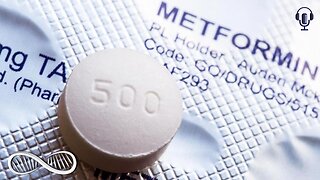Metformin - Uses, Mechanism Of Action, Adverse Effects & Contraindications
Metformin is an anti diabetic medication, belonging to the biguanide class of drugs. It is the first line treatment option for people with type two diabetes mellitus. Its major mechanism of action is to reduce hepatic gluconeogenesis by increasing the activity of an enzyme called Adenosine mono phosphate activated protein kinase, or AMPK for short. Following administration, metformin inhibits the mitochondrial respiratory chain complex in the cells, leading to decreased ATP levels, which is the main stimulus for activating AMPK.
AMPK is a key regulator of energy homeostasis within the cells. Activation of this enzyme increases the overall cellular catabolism, and reduces anabolism. It reduces hepatic gluconeogenesis by inhibiting the genes responsible for the synthesis of P E P carboxy kinase, and glucose 6 phosphatase, which are key enzymes of the gluconeogenesis pathway. It also increases the glucose uptake in the peripheral tissues by inducing translocation of GLUT 4 in to the cell membrane. In addition, AMPK increases fatty acid oxidation; decreases glycogen, protein, fatty acid, and cholesterol synthesis; decreases intestinal absorption of glucose; and reduces LDL cholesterol levels, while increasing HDL cholesterol. This reduces the cardiovascular disease risk in type 2 diabetic patients.
Most of the time, treatment of type 2 diabetes is started with metformin alone. However, if the patient is not responding well to mono therapy, metformin can be given in combination with other oral hypoglycemics, or insulin. It is available in immediate and slow release formulations, and is also indicated for the treatment of poly cystic ovarian syndrome and gestational diabetes. Considering pharmacokinetics of the drug, metformin has a 50 to 60% oral bio availability. And has a very low plasma protein binding. Duration of action is around 6 to 8 hours. Metformin is not metabolized by the liver. Therefore, it is excreted unchanged via kidneys by tubular secretion. For this reason, metformin is contraindicated in renal failure.
Finally let’s see some common adverse effects of metformin. This medication is usually well tolerated by most individuals. Weight loss is the most common adverse effect. Gastro intestinal disturbances such as abdominal discomfort; nausea and vomiting; and diarrhea may occur in some individuals. In addition, anorexia; and metallic taste are some other adverse effects. Hypo glycemia does not occur with metformin. Lactic acidosis is a rare, but serious adverse effect of metformin, especially in patients with hepatic and renal failure. Lactic acid is a product of anerobic respiration of the cells. Usually, this lactic acid is taken up by the liver, and utilized in the process of gluconeogenesis. However, as metformin inhibits gluconeogenesis, excess lactic acid is mainly excreted by the kidneys. If an individual with renal impairment takes metformin, lactic acid tends to accumulate in blood, causing serious complications. Therefore, metformin is contra indicated in patients with liver disease and renal failure.
#Metformin #MetforminSideEffects #MedToday
-
 2:23
2:23
Dr. Eric Berg
6 years agoThe Side Effects Of Metformin & How To Avoid Them – Dr. Berg
342 -
 0:14
0:14
Dr. Sam Robbins
2 years agoWhy Metformin Is 𝗕𝗮𝗱 𝗙𝗼𝗿 𝗬𝗼𝘂𝗿 𝗠𝘂𝘀𝗰𝗹𝗲𝘀?
8 -
 3:37
3:37
PrevMed Health
3 years agoWhy Metformin?
7 -
 4:44
4:44
bhstwo
11 months agoMetformin
65 -
 37:14
37:14
Gideonsedu
1 year agoDon't Take Metformin Before Seeing This (Watch Now)
13 -
 11:38
11:38
EdensLivingTV
1 year agoMisconceptions on how to treat DIABETES and the dangers of Metaformin
81 -
 10:41
10:41
Supplements, Sports Nutrition and Fitness
1 year agoCREATINE MONOHYDRATE | EFFECTS, SIDE EFFECTS, DANGERS, MYTHS & BENEFITS
6 -
 13:05
13:05
SuppsReviews
1 year agoLIVE FOREVER WITH METFORMIN - THE WORLDS FIRST ANTI-AGEING & FAT-LOSS DRUG…?
135 -
 2:18
2:18
Mental Health & Wellness
3 years agoSubstance Abuse & Micronutrients
24 -
 38:08
38:08
Limitless Mindset
7 months ago $0.03 earnedMetformin: This AMPK/mTOR Longevity Hack Stinks! What to take instead to hack insulin...
3451